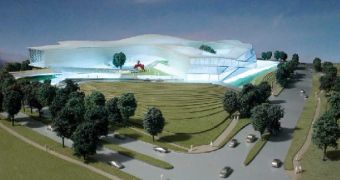Google’s ambitions seem to have no limit in sight so, after leaving its mark on the Internet and after trying to help the world help itself, the next logical step for the company is to build the greenest office there ever was. Consequently, it has submitted the plans to the Mountain View Planning Department this July. The papers describe an 88 feet (about 27 meters)-tall, 5-story building (garage included) with curved shapes and surfaces, comprising 3 courtyards. It would be completely carbon-free, and would try to exceed LEED platinum – the top score for an environmental building.
The 310,000 square foot (28,800 square meter)-wide building relies on a “courtyard circulation concept,” the halls of which will encircle open spaces. It will also be provided with an orchard, a park promenade and a bridge that will allow access to NASA Ames and to a large new campus Google intends to construct. According to the plans, the office will rather evolve in time instead of naturally decaying – “Typical building performance begins to degrade immediately upon completion of construction. In the Max Green model, monitoring and feedback allow the building to evolve as knowledge and information improve.”
Landscape architect for the project, Walter Hood, hopes that his site design would act as a buffer between the neighboring bay and the industrial zone. The slopes under the building level will help hide the garage, and will also ensure leading rainwater towards the green zones that need it. The roof of the building will be plant-covered, and will be designed in respect to the motion of the Sun, sporting next-gen solar panels. Ventilation of the building will most likely be wind-based, captured and directed by a clever design.
After studying the plans, Yvonne Farrell, a LEED-certified architect from Mountain View's Environmental Sustainability Task Force, believes that the costs shouldn't be higher than those of a class A one, and that they will pay off in time, say, in 10 or 20 years, given the self-sustainability of the project.
With all that, Google's Real Estate Vice President Dave Radcliffe thinks the project is not making sense yet, in spite of the company's high quarterly profits. “We're focused on making the most efficient use of the space we have,” he shared, although $1.7 million are invested yearly into leasing the 9-acre (36,422-square meter) building site.

 14 DAY TRIAL //
14 DAY TRIAL //